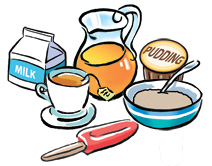A full liquid diet is a middle step between a clear liquid diet and eating solid foods. A clear liquid diet allows only liquids you can see through. A full liquid diet allows thicker liquid foods, as listed below. It can be anything that is liquid at room temperature. The full liquid diet may be used before or after surgery. Or it may be used if you have a digestive illness. It's also used before some medical tests. It's easy to digest and leaves little food in the stomach and intestines.
A full liquid diet meets calorie and protein needs for your body with liquids only. If it's to be used for more than 5 days, your healthcare provider or dietitian may also order high-protein, high-calorie liquid supplements. These will give you extra vitamins and minerals. You may include the items below on a full liquid diet.
Adults
Adults should drink a total of 2 to 3 quarts of liquid per day. It may be easier to drink small frequent servings rather than a few large ones. People with severe kidney or heart disease may need to limit the amount of fluid they take in. Check with your provider.
-
Cereals and soups. Creamy hot breakfast cereals (wheat or rice) thinned with milk, pureed soups (including pureed meats, bland vegetables, and white potatoes), tomato puree.
-
Desserts. Gelatin, whipped topping, custard-style yogurt, pudding, custard, plain ice cream, sherbet, sorbet, frozen fruit juice bars.
-
Drinks. Coffee, tea, cream, milk, milkshakes, fruit and vegetable juices, sodas, mineral water (plain or flavored), liquid gelatin, electrolyte replacement sports drinks.
-
Other items. Salt, mild-flavored seasonings, chocolate flavoring, gravy, margarine, sugar, syrup, jelly, honey, hard candy (to suck on).
Children
Follow the healthcare provider’s instructions. Young children who are eating solid foods may be able to have the items listed above without problems. Be sure to follow these safety measures:
-
Don't give hard candies to young children. The candies may cause choking.
-
Children under 1 year old. Don't give cow's milk or honey. It may cause illness.
-
Children under 2 years old. Ask your child’s provider if you should supplement your child’s diet with oral rehydration solutions, which have electrolytes. You can buy these drinks at pharmacies and grocery stores. You don’t need a prescription.
-
Children over 1 year old. Limit milk to 2 or 3 cups per day. Too much milk can make your child less hungry for other foods.


